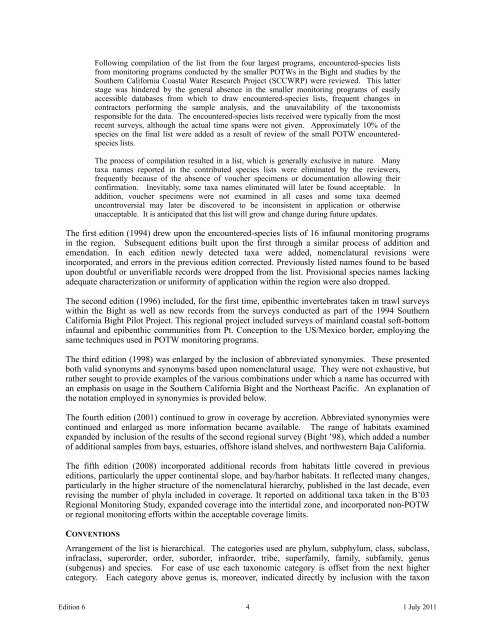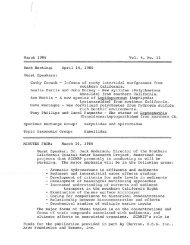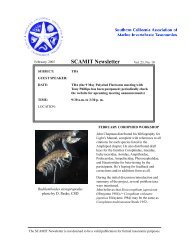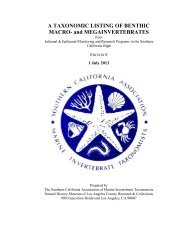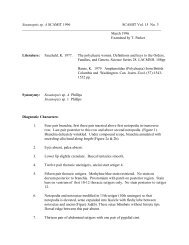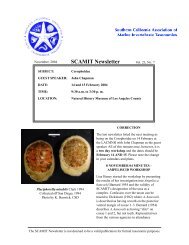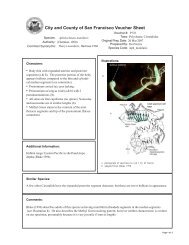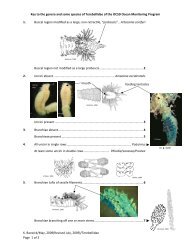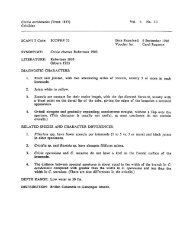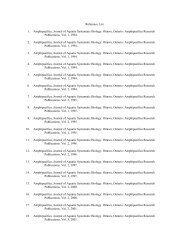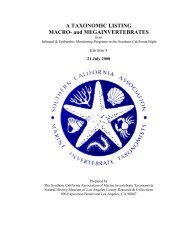Download - scamit
Download - scamit
Download - scamit
Create successful ePaper yourself
Turn your PDF publications into a flip-book with our unique Google optimized e-Paper software.
Following compilation of the list from the four largest programs, encountered-species lists<br />
from monitoring programs conducted by the smaller POTWs in the Bight and studies by the<br />
Southern California Coastal Water Research Project (SCCWRP) were reviewed. This latter<br />
stage was hindered by the general absence in the smaller monitoring programs of easily<br />
accessible databases from which to draw encountered-species lists, frequent changes in<br />
contractors performing the sample analysis, and the unavailability of the taxonomists<br />
responsible for the data. The encountered-species lists received were typically from the most<br />
recent surveys, although the actual time spans were not given. Approximately 10% of the<br />
species on the final list were added as a result of review of the small POTW encounteredspecies<br />
lists.<br />
The process of compilation resulted in a list, which is generally exclusive in nature. Many<br />
taxa names reported in the contributed species lists were eliminated by the reviewers,<br />
frequently because of the absence of voucher specimens or documentation allowing their<br />
confirmation. Inevitably, some taxa names eliminated will later be found acceptable. In<br />
addition, voucher specimens were not examined in all cases and some taxa deemed<br />
uncontroversial may later be discovered to be inconsistent in application or otherwise<br />
unacceptable. It is anticipated that this list will grow and change during future updates.<br />
The first edition (1994) drew upon the encountered-species lists of 16 infaunal monitoring programs<br />
in the region. Subsequent editions built upon the first through a similar process of addition and<br />
emendation. In each edition newly detected taxa were added, nomenclatural revisions were<br />
incorporated, and errors in the previous edition corrected. Previously listed names found to be based<br />
upon doubtful or unverifiable records were dropped from the list. Provisional species names lacking<br />
adequate characterization or uniformity of application within the region were also dropped.<br />
The second edition (1996) included, for the first time, epibenthic invertebrates taken in trawl surveys<br />
within the Bight as well as new records from the surveys conducted as part of the 1994 Southern<br />
California Bight Pilot Project. This regional project included surveys of mainland coastal soft-bottom<br />
infaunal and epibenthic communities from Pt. Conception to the US/Mexico border, employing the<br />
same techniques used in POTW monitoring programs.<br />
The third edition (1998) was enlarged by the inclusion of abbreviated synonymies. These presented<br />
both valid synonyms and synonyms based upon nomenclatural usage. They were not exhaustive, but<br />
rather sought to provide examples of the various combinations under which a name has occurred with<br />
an emphasis on usage in the Southern California Bight and the Northeast Pacific. An explanation of<br />
the notation employed in synonymies is provided below.<br />
The fourth edition (2001) continued to grow in coverage by accretion. Abbreviated synonymies were<br />
continued and enlarged as more information became available. The range of habitats examined<br />
expanded by inclusion of the results of the second regional survey (Bight ’98), which added a number<br />
of additional samples from bays, estuaries, offshore island shelves, and northwestern Baja California.<br />
The fifth edition (2008) incorporated additional records from habitats little covered in previous<br />
editions, particularly the upper continental slope, and bay/harbor habitats. It reflected many changes,<br />
particularly in the higher structure of the nomenclatural hierarchy, published in the last decade, even<br />
revising the number of phyla included in coverage. It reported on additional taxa taken in the B’03<br />
Regional Monitoring Study, expanded coverage into the intertidal zone, and incorporated non-POTW<br />
or regional monitoring efforts within the acceptable coverage limits.<br />
CONVENTIONS<br />
Arrangement of the list is hierarchical. The categories used are phylum, subphylum, class, subclass,<br />
infraclass, superorder, order, suborder, infraorder, tribe, superfamily, family, subfamily, genus<br />
(subgenus) and species. For ease of use each taxonomic category is offset from the next higher<br />
category. Each category above genus is, moreover, indicated directly by inclusion with the taxon<br />
Edition 6 4 1 July 2011


